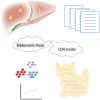Bibliometric and LDA analysis of acute rejection in liver transplantation: Emerging trends, immunotherapy challenges, and the role of artificial intelligence
- PMID: 40152403
- PMCID: PMC11951891
- DOI: 10.1177/09636897251325628
Bibliometric and LDA analysis of acute rejection in liver transplantation: Emerging trends, immunotherapy challenges, and the role of artificial intelligence
Abstract
With the rising demand for liver transplantation (LT), research on acute rejection (AR) has become increasingly diverse, yet no consensus has been reached. This study presents a bibliometric and latent Dirichlet allocation (LDA) topic modeling analysis of AR research in LT, encompassing 1399 articles. The United States, Zhejiang University, and the University of California, San Francisco emerged as leading contributors, while Levitsky J and Uemoto SJ were key researchers. The most influential journals included the American Journal of Transplantation, Journal of Hepatology, and Transplantation. The analysis reveals a transition from traditional histological assessments to molecular diagnostics, genetic and epigenetic profiling, and noninvasive biomarkers such as donor-derived cell-free DNA (dd-cfDNA) and microRNAs. Advances in immune checkpoint inhibitors (ICIs), cell-based therapies (Tregs, mesenchymal stem cells (MSCs)), AI-guided immunosuppression, and nanoparticle-mediated drug delivery systems reflect a growing emphasis on precision medicine. In addition, recent exploration of microbiome-based therapies and regenerative medicine, including MSCs and their extracellular vesicles, offers promising new avenues for reducing long-term immunosuppressive drug dependency and enhancing graft survival. These developments not only improve early AR detection and personalized treatment but also reduce toxicity, foster immune tolerance, and expand the scope of individualized therapeutic options. Global collaboration, supported by cutting-edge research and AI-driven decision-making, remains essential for refining AR strategies, improving graft survival, and achieving better long-term patient outcomes.
Keywords: acute rejection; bibliometric analysis; latent Dirichlet allocation; liver transplantation.
Conflict of interest statement
Declaration of conflicting interestsThe author(s) declared no potential conflicts of interest with respect to the research, authorship, and/or publication of this article.
Figures











Similar articles
-
Application of artificial intelligence in rheumatic disease: a bibliometric analysis.Clin Exp Med. 2024 Aug 23;24(1):196. doi: 10.1007/s10238-024-01453-6. Clin Exp Med. 2024. PMID: 39174664 Free PMC article.
-
The role of artificial intelligence in immune checkpoint inhibitor research: A bibliometric analysis.Hum Vaccin Immunother. 2024 Dec 31;20(1):2429893. doi: 10.1080/21645515.2024.2429893. Epub 2024 Nov 28. Hum Vaccin Immunother. 2024. PMID: 39610043 Free PMC article.
-
Knowledge domain and frontier trends of artificial intelligence applied in solid organ transplantation: A visualization analysis.Int J Med Inform. 2025 Mar;195:105782. doi: 10.1016/j.ijmedinf.2024.105782. Epub 2024 Dec 31. Int J Med Inform. 2025. PMID: 39761617
-
Artificial intelligence in kidney transplantation: a 30-year bibliometric analysis of research trends, innovations, and future directions.Ren Fail. 2025 Dec;47(1):2458754. doi: 10.1080/0886022X.2025.2458754. Epub 2025 Feb 5. Ren Fail. 2025. PMID: 39910843 Free PMC article. Review.
-
Global research hotspots and trends of acute rejection after liver transplantation from 1988 to 2022: a bibliometric analysis.Front Pharmacol. 2024 Apr 17;15:1357468. doi: 10.3389/fphar.2024.1357468. eCollection 2024. Front Pharmacol. 2024. PMID: 38694927 Free PMC article.
References
-
- Levitsky J, Goldberg D, Smith AR, Mansfield SA, Gillespie BW, Merion RM, Lok AS, Levy G, Kulik L, Abecassis M, Shaked A. Acute rejection increases risk of graft failure and death in recent liver transplant recipients. Clin Gastroenterol Hepatol. 2017;15(4):584–93. doi:10.1016/j.cgh.2016.07.035. - DOI - PMC - PubMed
-
- Lee SK, Choi JY, Jung ES, Kwon JH, Jang JW, Bae SH, Yoon SK. An immunological perspective on the mechanism of drug induced liver injury: focused on drugs for treatment of hepatocellular carcinoma and liver transplantation. Int J Mol Sci. 2023;24(5):5002. doi:10.3390/ijms24055002. - DOI - PMC - PubMed
MeSH terms
LinkOut - more resources
Full Text Sources
Medical
Research Materials

